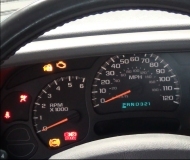There's two common things I can think of for the symptoms you described. The first has to do only with the 2.5L four-cylinder engine and its 2.2L little brother. That is the pick-up assembly in the distributor. They often fail by becoming heat-sensitive, then they work again after cooling down for about an hour. It's more common for them to cause total stalling, not just a gradual loss of power. With a total failure, start by checking for spark. For others researching this topic who may not be familiar with this, here's a link to an article that explains how to do this:
https://www.2carpros.com/articles/how-to-test-an-ignition-system
The next common, but elusive cause is a plugged pick-up screen inside the gas tank. Don't confuse that with the gas filter. Other than with diesel engines, you'll never solve a running problem on a Chrysler product by replacing the fuel filter. They typically last the life of the vehicle unless they rust out and start leaking. The sock in the tank is a different story. The common symptom when they become plugged or collapsed is the engine runs fine for up to 15 to 20 minutes, then it tends to want to stall when the highest volume of fuel is being pumped, which is during coasting. It runs okay while cruising at higher speeds.
To verify a plugged sock in the tank, connect a fuel pressure gauge and route it under the rear of the hood, then clip it under a wiper arm so you can watch it while you're driving. This has happened four times to me, twice on my '88 Grand Caravan. The second time, by watching that gauge, I was able to nurse it home 50 miles while dragging a tandem axle enclosed trailer that's bigger and heavier than the van. I had been pursuing this intermittent problem for over a year, so I had the fuel pressure gauge strapped to the radio antenna. Normal fuel pressure is around 45 psi, but it would slowly drop to less than 20 psi. Many other brands of engines won't even run with fuel pressure that's just five pounds low. Mine started to misfire at 15 psi. I found if I lifted the accelerator pedal for just an instant, the pressure would instantly pop back up to 45 psi, then I could drive another 20 to 30 seconds before I had to do it again. The high load with the trailer is what finally made this act up consistently.
That 45 psi is for the 3.0L six-cylinder engine. If you have a 2.5L with a single injector, normal fuel pressure is 14 psi with the engine running. It will be higher with the engine off and no vacuum applied to the fuel pressure regulator.
There's another potential cause for this, but it usually goes from intermittent to a total failure within hours or a few days. That is the MAP sensor. GM designed the original sensor and had a huge rash of failures, so they sold them to Chrysler. Within a year or two they all failed and were replaced with a different design that has been very trouble-free. Regardless, they do have the biggest say in the fuel metering calculations. Depending on which engine you have, you may find this sensor on the right strut tower. If you do, there is a service bulletin that might apply. It involves teeing into both ends of the sensor's vacuum hose and running a second, parallel hose. Sounds stupid, but it did solve the problem of gas vapors condensing in a low spot in that hose, then the liquid gas blocked the vacuum signal.
Problems with the MAP sensor circuit will eventually be detected and a diagnostic fault code will be set. You'll find that when reading those codes. The best way to do that is with a scanner or code reader, but Chrysler made doing that yourself much easier than any other manufacturer. Cycle the ignition switch from "off" to "run" three times within five seconds without cranking the engine, leave it in "run", then count the flashes of the Check Engine light. On most models you'll see one flash, a short pause, two flashes, then a longer pause before a second two-digit code is flashed. That's code 12 which can be ignored. It just means the ignition switch was turned off recently. Also, the last code will be code 55. That just means it's done. Ignore that one too. You can go here:
https://www.2carpros.com/articles/retrieve-trouble-codes-for-chrysler-dodge-plymouth-odb1-1995-and-earlier-car-mini-van-and-light-trucks
to see the definitions, or I can interpret them for you. Be aware not all fault codes turn on the Check Engine light while you're driving. Only about half of the things that can be detected involve something that could adversely affect emissions. Those are the codes that turn the Check Engine light on.
Tuesday, August 10th, 2021 AT 5:51 PM




